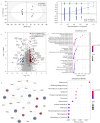[Impact of arsenic exposure on the hepatic metabolic molecular network in obese pregnant mice using metabolomics and proteomics]
- PMID: 39722621
- PMCID: PMC11686477
- DOI: 10.3724/SP.J.1123.2024.05028
[Impact of arsenic exposure on the hepatic metabolic molecular network in obese pregnant mice using metabolomics and proteomics]
Abstract
Arsenic is a ubiquitous environmental toxin that can affect normal physiological processes. Although the health impacts of arsenic have been investigated, its influence on hepatic metabolism in obese pregnant women and the underlying mechanisms remain unclear. Multi-omics analysis, including metabolomics and proteomics, can improve the understanding of arsenic-induced hepatotoxicity in obese pregnant women. This study aimed to investigate the adverse effects of gestational arsenic exposure on hepatic metabolism in high-fat-diet-induced obese pregnant mice. Following arsenic exposure during pregnancy, the liver tissue was evaluated comprehensively using metabolomics and proteomics techniques combined with pathological and biochemical analyses. Arsenic exposure not only significantly increased lipid accumulation in the livers of obese pregnant mice but also elevated inflammatory factors and oxidative stress markers. Specifically, histopathological examination revealed more steatosis, inflammatory cell infiltration, and hepatocyte ballooning in the livers of arsenic-exposed mice than in those of controls. These changes indicate that arsenic exposure exacerbates hepatic lipid accumulation and induces liver damage in the context of obesity. Metabolomic analysis provided further insight into the metabolic-level disruption caused by arsenic exposure. Significant changes were observed in lipid metabolism pathways, particularly the arachidonic acid metabolism pathway. As arachidonic acid and its metabolites play important roles in inflammation and oxidative stress, this pathway may be critical in arsenic-induced hepatotoxicity. Additionally, proteomic analysis showed differences in the expression levels of several key proteins involved in lipid synthesis, oxidative stress, and inflammatory response. Notably, oxidative-stress-related proteins, including glutathione peroxidase 4 (GPX4), were upregulated, suggesting an increased oxidative burden. In summary, there are complex interaction mechanisms among arsenic exposure, inflammatory response, and related lipid metabolism. The integration of metabolomics and proteomics aided in clarifying the molecular alterations induced by arsenic. The results show that arsenic exposure significantly affects hepatic lipid metabolism in obese pregnant mice through multiple metabolic pathways and protein regulatory mechanisms. In addition to providing new insights into the relationship between arsenic exposure and obesity as well as related metabolic diseases, this study can act as a reference for environmental health risk assessment and the formulation of public health policies. This enhanced understanding of the adverse effects of arsenic on hepatic metabolism will contribute to the development of strategies for mitigating the health risks associated with environmental toxins, particularly for vulnerable groups such as obese pregnant women.
砷是普遍存在的环境毒物,可能影响生物体的正常生理过程。尽管已有研究探讨了砷对健康的影响,但砷暴露对肥胖孕妇肝脏代谢的影响及其作用机制尚不明确。本研究旨在通过高脂饮食诱导肥胖孕鼠模型,并采用灌胃方式模拟孕期砷暴露,以探究其对肝脏代谢的影响。孕鼠砷暴露后,我们利用代谢组学和蛋白组学技术,结合病理生化分析,对肝脏组织进行了深入研究。结果显示,砷暴露显著增加了肥胖孕鼠肝脏中的脂质累积,并伴随着炎症因子和氧化应激标志物的升高。代谢组学分析揭示了砷暴露对脂质代谢通路,特别是花生四烯酸代谢的显著影响。此外,蛋白组学分析确认了与脂质合成、氧化应激和炎症反应相关的蛋白质表达水平发生了变化。这些结果表明,砷暴露可能通过多种代谢途径和蛋白质调节通路,对肥胖孕鼠肝脏的脂质代谢产生显著影响。本研究不仅为理解砷暴露与肥胖及相关代谢性疾病之间的关系提供了新的科学视角,也为环境健康风险评估和公共卫生政策的制定提供了重要参考。
Keywords: arsenic; liver; metabolomics; obesity; pregnant mice; proteomics.
Figures
Similar articles
-
Untargeted metabolomics and transcriptomics joint analysis of the effects of polystyrene nanoplastics on lipid metabolism in the mouse liver.Lipids Health Dis. 2025 May 29;24(1):195. doi: 10.1186/s12944-025-02613-7. Lipids Health Dis. 2025. PMID: 40442648 Free PMC article.
-
Metabolomics Analysis and Biochemical Profiling of Arsenic-Induced Metabolic Impairment and Disease Susceptibility.Biomolecules. 2023 Sep 20;13(9):1424. doi: 10.3390/biom13091424. Biomolecules. 2023. PMID: 37759824 Free PMC article.
-
Di-2-ethylhexyl phthalate disrupts hepatic lipid metabolism in obese mice by activating the LXR/SREBP-1c and PPAR-α signaling pathways.Sci Total Environ. 2024 Mar 1;914:169919. doi: 10.1016/j.scitotenv.2024.169919. Epub 2024 Jan 8. Sci Total Environ. 2024. PMID: 38199361
-
Exploring the liver toxicity mechanism of Tripterygium wilfordii extract based on metabolomics, network pharmacological analysis and experimental validation.J Ethnopharmacol. 2025 Jan 30;337(Pt 2):118888. doi: 10.1016/j.jep.2024.118888. Epub 2024 Oct 3. J Ethnopharmacol. 2025. PMID: 39368758 Review.
-
Omics advancements towards exploring arsenic toxicity and tolerance in plants: a review.Planta. 2025 Mar 5;261(4):79. doi: 10.1007/s00425-025-04646-9. Planta. 2025. PMID: 40044842 Free PMC article. Review.
Cited by
-
Walnut Green Husk Extract Enhances Antioxidant, Anti-Inflammatory, and Immune Functions by Regulating Gut Microbiota and Metabolites in Fattening Pigs.Animals (Basel). 2025 Aug 15;15(16):2395. doi: 10.3390/ani15162395. Animals (Basel). 2025. PMID: 40867723 Free PMC article.
References
-
- World Health Organization. . Obesity and Overweight. (2024-03-01) [2024-05-29]. https://www.who.int/news-room/fact-sheets/detail/obesity-and-overweight https://www.who.int/news-room/fact-sheets/detail/obesity-and-overweight
-
- Amir M, Asghar S, Ahsin M, et al. . Environ Geochem Health, 2021, 43(12): 5025 - PubMed
Publication types
MeSH terms
Substances
LinkOut - more resources
Full Text Sources
Medical
Research Materials




